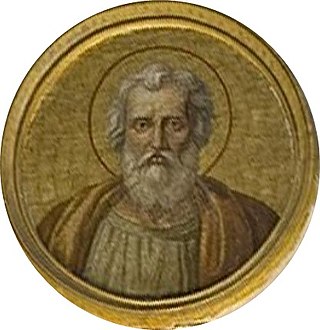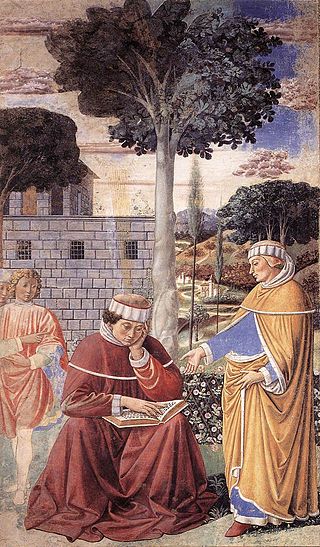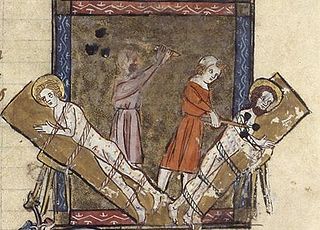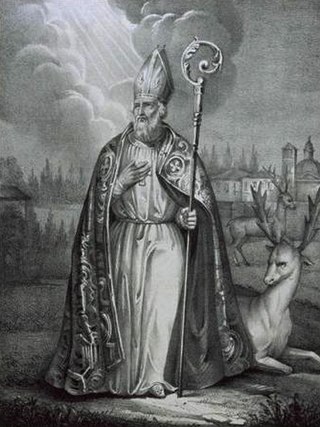Related Research Articles

Antipope Felix was a Roman archdeacon in the 4th century who was installed irregularly in 355 as an antipope and reigned until 365 after Emperor Constantius II banished the then current pope, Liberius. Constantius, following the refusal of the laity to accept Felix, attempted to have them co-rule, but Felix was forced to retire. He was resented in his lifetime but has enjoyed a more popular memory since.

Paulinus of Nola born Pontius Meropius Anicius Paulinus, was a Roman poet, writer, and senator who attained the ranks of suffect consul and governor of Campania but – following the assassination of the emperor Gratian and under the influence of his Hispanic wife Therasia of Nola — abandoned his career, was baptized as a Christian, and probably after Therasia's death became bishop of Nola in Campania. While there, he wrote poems in honor of his predecessor Saint Felix and corresponded with other Christian leaders throughout the empire. He is credited with the introduction of bells to Christian worship and helped resolve the disputed election of Pope Boniface I.
Pope Felix I was the bishop of Rome from 5 January 269 to his death on 30 December 274.

Pope Felix IV was the bishop of Rome from 12 July 526 to his death. He was the chosen candidate of Ostrogoth King Theodoric the Great, who had imprisoned Felix's predecessor, John I.

The calendar of saints is the traditional Christian method of organizing a liturgical year by associating each day with one or more saints and referring to the day as the feast day or feast of said saint. The word "feast" in this context does not mean "a large meal, typically a celebratory one", but instead "an annual religious celebration, a day dedicated to a particular saint".

Saint Lawrence or Laurence was one of the seven deacons of the city of Rome under Pope Sixtus II who were martyred in the persecution of the Christians that the Roman Emperor Valerian ordered in 258.

Peter Chrysologus was Bishop of Ravenna from about 433 until his death. He is known as the “Doctor of Homilies” for the concise but theologically rich reflections he delivered during his time as the Bishop of Ravenna.

Alypius of Thagaste was bishop of the see of Tagaste in 394. He was a lifelong friend of Augustine of Hippo and joined him in his conversion and life in Christianity. He is credited with helping establish Augustine's monastery in Africa. Most of what is known about him comes from Augustine's autobiographical Confessions.
Dom Ambrose Griffiths was a Benedictine abbot before becoming a Roman Catholic bishop in the Catholic Church in England and Wales.

Saints Gervasius and Protasius are venerated as Christian martyrs, probably of the 2nd century. They are the patron saints of Milan and of haymakers and are invoked for the discovery of thieves. Their feast day in the Latin Rite of the Catholic Church is 19 June, the day marking the translation of their relics. In the Eastern Orthodox Church and in the Eastern Rites of the Catholic Church, their feast takes place on 14 October (O.S.)/24 October (N.S.), the traditional day of their death. In Christian iconography their emblems are the scourge, the club and the sword.

Nabor and Felix were Christian martyrs thought to have been killed during the Great Persecution under the Roman emperor Diocletian. A tomb in Milan is believed to contain their relics.
This article lists the feast days of the General Roman Calendar as they were at the end of 1954. It is essentially the same calendar established by Pope Pius X (1903–1914) following his liturgical reforms, but it also incorporates changes that were made by Pope Pius XI (1922–1939), such as the institution of the Feast of Christ the King, and the changes made by Pope Pius XII (1939–1958) prior to 1955, chief among them the imposition of the Feast of the Immaculate Heart of Mary upon the universal Church in 1944, the inscription of Pius X into the General Calendar following his 1954 canonization, and the institution of the Feast of the Queenship of Mary in October 1954.

Simplician was Bishop of Milan from 397 to 400 or 401 AD. He is honoured as a Saint in the Roman Catholic and Eastern Orthodox Churches and his feast day is August 14.

Bassianus of Lodi was an Italian saint, the patron saint of Lodi and Pizzighettone in Italy.

Maternus was Archbishop of Milan from c. 316 to c. 328. He is honoured as a Saint in the Catholic Church and his feast day is on July 18.
Amantius of Como is venerated as the third bishop of Como. He was preceded by Felix of Como and Provinus. He was succeeded by Abundius. His feast day is 8 April.

Juan de la Caridad García Rodríguez is a Cuban prelate of the Catholic Church who has served as Archbishop of Havana since 26 April 2016. He previously served as an Auxiliary Bishop of Camagüey from 1997 to 2002 and then as Archbishop of that diocese from 2002 to 2016. He is a past president of the Cuban Conference of Catholic Bishops. Pope Francis raised him to the rank of cardinal on 5 October 2019.

Senator of Milan or Senator of Settala was Bishop of Milan from 472 to 475. He is honoured as a saint in the Eastern Orthodox Church and Catholic Church and his feast day is 28 May.

Justus of Lyon was the 13th Bishop of Lyon. He succeeded Verissimus in the mid-4th century. He is venerated as a saint by both the Catholic and the Orthodox Church, with a feast day on 2 September. Around 350, Justus was made Bishop of Lyon. As bishop of the capital of Gaul, he was among the participants of the Council of Valencia of 374 regarding religious discipline of the clergy and the faithful. He later became a hermit.

Felix of Trier was bishop of Trier from around 386 to 398.
References
- ↑ "New Advent Catholic Encyclopedia".
- ↑ Morabito, Giuseppe. "San Bassiano", Santi e Beati
- ↑ Monks of Ramsgate. "Felix of Como". Book of Saints 1921. CatholicSaints.Info. 9 April 2013
 This article incorporates text from this source, which is in the public domain .
This article incorporates text from this source, which is in the public domain . - ↑ "Saint Feast Days in July - Saint Feast Days - Saints & Angels".